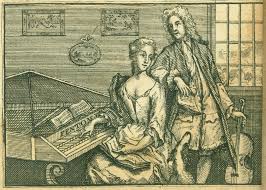Biography:Alexander Stuart
Alexander Stuart
| |
|---|---|
| Given name: | Alexander |
| Middle name: | |
| Family name: | Stuart (sometimes Stewart) |
| Place of birth: | |
| Place of death: | |
| Year of birth: | c. 1695 |
| Year of death: | |
| Profile: | |
| Source of information: | |
Biographical notes
ALEXANDER STUART. Alexander Stuart (sometimes 'Stewart') was born about 1695, according to David Baptie (Musical Scotland, p. 182), who identifies him as a "vocal composer." Stuart's Musick for Songs in Allan Ramsay's Collection (c. 1724) is a volume of instrumental settings of songs (with simple bass lines) in poet Allan Ramsay's Tea Table Miscellany which had been published around 1723 or 1724 without music (later editions of the 'Miscellany' included the music). Stuart's settings (engraved by Richard Cooper) were published separately by Ramsay soon after the issue of the "Miscellany". It was issued in six parts from 1724-1726, later bound into one; each part was dedicated to a female patron[1]. Stuart does not seem to have any other publications in his name. Ramsay may also have been interested in publishing the airs to his songs as he recognized them in response the the melodies as set by William Thomson Orpheus Caledonius (1725), which he considered overly-ornamented[2].
Ramsay probably met both Stuart and Cooper at the Music Club in Edinburgh. The later Edinburgh Music Society employed Stuart until around 1736[3], but there are payments to Stuart in the accounts of the Music Society over a forty year period, from 1727 to 1767, where he was paid as a performer and as a supplier of strings and instruments[4]. Stuart is known to have been a violinist and singer, and his arrangements of melodies indicated in the 'Miscellany' are simple and straightforward, and presumably faithful to the versions that would have been familiar to most of Ramsay's readers. However, as McGuinness & McGregor[5] explain, there are problems:

Stuart’s arrangements were clearly no designed purely as vocal settings: no song texts are included with the music, and although no instrumentation is named, the frontispiece features and illustration of a violinist holding and unexpectedly large violin, and a spinet player whose instrument has been engraved in reverse. While lacking the dense ornamentation of Orpheus Caledonius, many vocal difficulties are also present in Stuart’s melodies, including the use of a high register, wide leaps, and written out flourishes and melismas. Even more problematic is the fact that the music often fails to comfortably fit Ramsay’s songs. Extended passages of shore notes can obscure the rhythms of the verse, line endings have extra notes which seem to imply more syllables per line than Ramsay provides, and on many occasions the only possible fit of words to music leads to awkward wide leaps on a single syllable.
- ↑ One part was dedicated to Susanna Montgomery (née Kennedy), the Countess of Eglinton, who was also the dedicatee of Ramsay's Gentle Shepherd (1725).
- ↑ It is not quite clear which volume, Stuart's or Thomson's was published first.
- ↑ Murray Pittock, "Allan Ramsay: Romanticism and Reception", 2020, p. 10 [1]. The Society also employed violinists Adam Craig and William McGibbon, both of whom issued collections of popular Scottish airs and melodies
- ↑ Jennifer Macleod, "The Edinburgh Musical Society: Its Membership and Repertoire 1728-1797", Unpublished PhD thesis, University of Edinburgh, 2001, pp. 150-151.
- ↑ David McGuinness, Aaron McGregor, “Ramsay’s Musical Sources: Reconstructing a Poet’s Musical Memory”, Scottish Literary Review, vol. 10, No. 1, Spring/Summer 2018.
